Related Research Articles

A firearm is any type of gun designed to be readily carried and used by an individual. The term is legally defined further in different countries.

Gun safety is the study and practice of using, transporting, storing and disposing of firearms and ammunition, including the training of gun users, the design of weapons, and formal and informal regulation of gun production, distribution, and usage, for the purpose of avoiding unintentional injury, illness, or death. This includes mishaps like accidental discharge, negligent discharge, and firearm malfunctions, as well as secondary risks like hearing loss, lead poisoning from bullets, and pollution from other hazardous materials in propellants and cartridges. There were 47,000 unintentional firearm deaths worldwide in 2013.

Shooting sports is a group of competitive and recreational sporting activities involving proficiency tests of accuracy, precision and speed in shooting — the art of using ranged firearms, mainly referring to man-portable guns and bows/crossbows.

A muzzle brake or recoil compensator is a device connected to, or a feature integral to the construction of, the muzzle or barrel of a firearm or cannon that is intended to redirect a portion of propellant gases to counter recoil and unwanted muzzle rise. Barrels with an integral muzzle brake are often said to be ported.
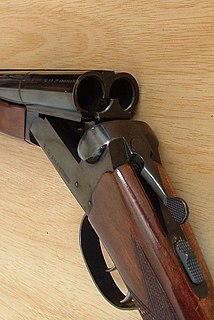
In firearms terminology, an action is the functional mechanism of a breech-loading firearm that handles the ammunition cartridges, or the method by which that mechanism works. Actions are technically not present on muzzleloaders, as all those are single-shot firearms with a closed off breech with the powder and projectile manually loaded from the muzzle. Instead, the muzzleloader ignition mechanism is referred to as the lock.
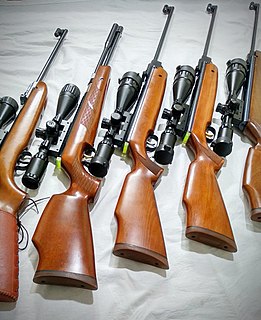
An air gun or airgun is a gun that fires projectiles pneumatically with compressed air or other gases that are mechanically pressurized without involving any chemical reactions, in contrast to a firearm, which pressurizes gases chemically via oxidation of combustible propellants that generates propulsive energy by breaking molecular bonds.

The .40 S&W is a rimless pistol cartridge developed jointly by American firearms manufacturers Smith & Wesson and Winchester in 1990. The .40 S&W was developed from the ground up as a law enforcement cartridge designed to duplicate performance of the Federal Bureau of Investigation's (FBI) reduced-velocity 10mm Auto cartridge which could be retrofitted into medium-frame semi-automatic handguns. It uses 0.40-inch (10 mm) diameter bullets ranging in weight from 105 to 200 grains.

A wadcutter is a special-purpose flat-fronted bullet specifically designed for shooting paper targets, usually at close range and at subsonic velocities typically under approximately 900 ft/s (274 m/s). Wadcutters have also found favor for use in self-defense guns, such as .38 caliber snubnosed revolvers, where, due to short barrel lengths, maximum bullet velocities are usually low, typically under 900 ft/s (274 m/s), and improved lethality is desired. Wadcutters are often used in handgun and airgun competitions.

A gun barrel is a crucial part of gun-type ranged weapons such as small firearms, artillery pieces and air guns. It is the straight shooting tube, usually made of rigid high-strength metal, through which a contained rapid expansion of high-pressure gas(es) is used to propel a projectile out of the front end (muzzle) at a high velocity. The hollow interior of the barrel is called the bore, and the diameter of the bore is called its caliber, usually measured in inches or millimetres.
Internal ballistics, a subfield of ballistics, is the study of the propulsion of a projectile.

In firearms, headspace is the distance measured from a closed chamber's breech face to the chamber feature that limits the insertion depth of a cartridge placed in it. Used as a verb by firearms designers, headspacing refers to the act of stopping deeper cartridge insertion. The exact part of the cartridge that seats against the limiting chamber feature differs among cartridge and gun designs. Bottleneck rifle cartridges headspace on their case shoulders; rimmed cartridges headspace on the forward surfaces of their case rims; belted cartridges headspace on the forward surfaces of their case belts; rimless pistol cartridges headspace on their case mouths.
The .256 Winchester Magnum is a firearms cartridge developed by Winchester, and was produced by necking-down a .357 Magnum cartridge to .257 diameter. It was designed for shooting small game and varmints.
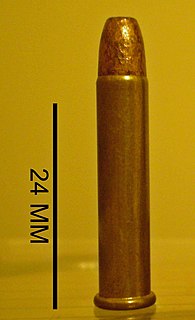
The .22 Winchester Magnum Rimfire, also called .22 WMR, .22 Magnum, .22 WMRF, .22 MRF, or .22 Mag, is a rimfire cartridge. Originally loaded with a bullet weight of 40 grains (2.6 g) delivering velocities in the 2,000 feet per second (610 m/s) range from a rifle barrel, .22 WMR is now loaded with bullet weights ranging from 50 grains (3.2 g) at 1,530 feet per second (470 m/s) to 30 grains (1.9 g) at 2,200 feet per second (670 m/s).
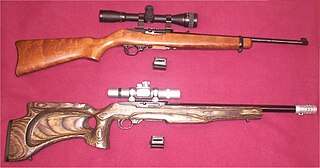
Accurizing is the process of improving the accuracy and precision of a gun.

Metallic silhouette shooting is a group of target shooting disciplines that involves shooting at steel targets representing game animals at varying distances, seeking to knock the metal target over. Metallic silhouette is shot with large bore rifles fired freehand without support out to 500 meters, and with large bore handguns from the prone position with only body support out to 200 meters. Competitions are also held with airguns and black-powder firearms. A related genre is shot with bow and arrow, the metal targets being replaced with cardboard or foam. The targets used are rams, turkeys, pigs, and chickens, which are cut to different scales and set at certain distances from the shooter depending on the specific discipline.

American Rifleman is a United States-based monthly shooting and firearms interest publication, owned by the National Rifle Association (NRA). It is the 33rd-most-widely-distributed consumer magazine and the NRA's primary magazine. The magazine has its headquarters in Fairfax, Virginia.
The following are terms related to firearms and ammunition topics.
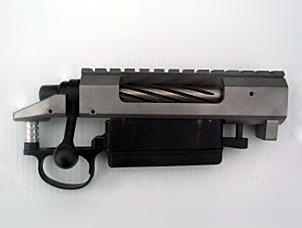
In firearms terminology, fluting refers to the removal of material from a cylindrical surface, usually creating grooves. This is most often the barrel of a rifle, though it may also refer to the cylinder of a revolver or the bolt of a bolt action rifle. In contrast to rifle barrels and revolver cylinders, rifle bolts are normally helically fluted, though helical fluting is sometimes also applied to rifle barrels.
A firearm malfunction is the failure of a firearm to operate as intended for causes other than user error. Malfunctions range from temporary and relatively safe situations, such as a casing that did not eject, to potentially dangerous occurrences that may permanently damage the gun and cause injury or death. Improper handling of certain types of malfunctions can be very dangerous. Following gun safety rules can prevent firearm malfunctions, and limit the damage inflicted by them if they do occur. Proper cleaning and maintenance of a firearm play a big role in preventing malfunctions.

A silencer, also known as a sound suppressor, suppressor or sound moderator, is a muzzle device that reduces the acoustic intensity of the muzzle report and the recoil when a gun is discharged, by modulating the speed and pressure of the propellant gas from the muzzle and hence suppressing the muzzle blast. Like other muzzle devices, a silencer can be a detachable accessory mounted to the muzzle, or an integral part of the barrel.
References
- ↑ Association, National Rifle. "An NRA Shooting Sports Journal | How To Avoid Revolver Forcing Cone Failure". An NRA Shooting Sports Journal. Retrieved 2022-06-10.
- ↑ Kokalis, Peter G. (2016-08-19). "Era of the Classic Snubnose Revolver". Firearms News. Retrieved 2022-06-10.